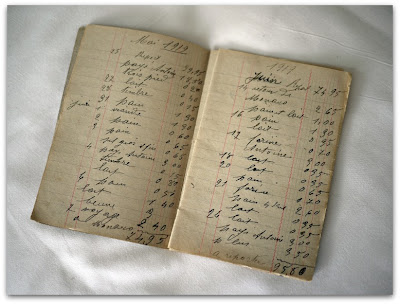Years ago when we first moved to the south of France, we wandered into a charming little art gallery on a pedestrian street in San Remo, Italy and found this painting of a beautiful woman. Hubby and I fell in love with her instantly so after an hour or so of spirited Italian-style haggling, she was ours.
For 12 years now, she's been quietly overseeing dinners we host in our dining room and I always make it a point of seating my guests on the south side of the dining room table so they can see her while they dine. Especially the men!
There she is, smiling enigmatically while dinner progresses from appetizers to dessert to espresso, and then hours later with full and happy bellies, we part ways and drift en masse to the salon.
 It's a lovely painting but the thing I find most striking about it is the contrast between her face and the other elements of the painting. She's no spring chicken yet her pose, her basket of luscious blood oranges and her exposed breast all say youth and sensual bounty yet her face says maturity and wisdom.
It's a lovely painting but the thing I find most striking about it is the contrast between her face and the other elements of the painting. She's no spring chicken yet her pose, her basket of luscious blood oranges and her exposed breast all say youth and sensual bounty yet her face says maturity and wisdom.
There she is, smiling enigmatically while dinner progresses from appetizers to dessert to espresso, and then hours later with full and happy bellies, we part ways and drift en masse to the salon.
 It's a lovely painting but the thing I find most striking about it is the contrast between her face and the other elements of the painting. She's no spring chicken yet her pose, her basket of luscious blood oranges and her exposed breast all say youth and sensual bounty yet her face says maturity and wisdom.
It's a lovely painting but the thing I find most striking about it is the contrast between her face and the other elements of the painting. She's no spring chicken yet her pose, her basket of luscious blood oranges and her exposed breast all say youth and sensual bounty yet her face says maturity and wisdom.
I was thinking about her and how much she reminded me of fruit trees we have growing in our garden in France. Some of the trees
are 50-100 years old, what would be considered quite young for fruit trees yet
year after year they produce a prolific
number of luscious fruit, with little or no assistance. It's quite magical.
Every summer when I return to Ottawa for an annual visit, I fill a suitcase with home made citrus marmalade to sell at the incomparable annual Great Glebe Garage sale in our old neighbourhood to raise funds for the Nepal Youth Foundation. The marmalade is made from bitter oranges, lemons, kumquats and mandarins from these mature citrus trees in our terraced gardens that hug the mountainside overlooking the Mediterranean Sea.
Every summer when I return to Ottawa for an annual visit, I fill a suitcase with home made citrus marmalade to sell at the incomparable annual Great Glebe Garage sale in our old neighbourhood to raise funds for the Nepal Youth Foundation. The marmalade is made from bitter oranges, lemons, kumquats and mandarins from these mature citrus trees in our terraced gardens that hug the mountainside overlooking the Mediterranean Sea.
I hope that under our guardianship the trees remain healthy for years to come. And just like the woman in the painting, the contrast between the mature age of our trees and the fresh, and delicious bounty they produce is one in the same. And a pleasure to share.
















